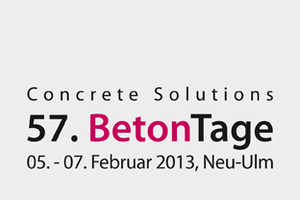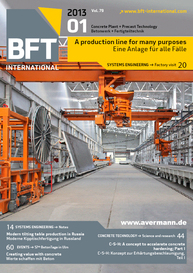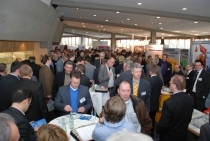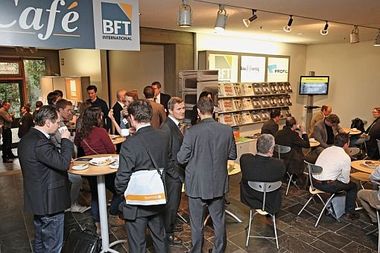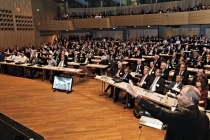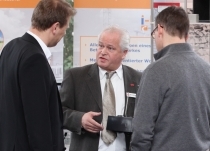Creating value with concrete
From 5 to 7 February 2013, the Edwin-Scharff-HausCongress Center in Neu-Ulm will again be hosting the world of concrete. The 57th BetonTage edition will be held under the heading of “Creating value”. About 2,000 attendees are expected to participate in Europe’s largest precast industry event, which will be presenting the United Kingdom as the 2013 guest country. Keynote speakers are Anselm Bilgri, management consultant and former prior of the Andechs monastery, and Prof. Mike Schlaich, of schlaich bergermann und partner, who will reflect upon the umbrella themes of the event, each from his own perspective. Featuring high-profile speakers from research and industry, the congress will provide a wealth of information on industry trends in standardization, concrete technology and production processes. As previously, the program includes not only the plenary sessions but also several product-specific panels to be held simultaneously in the afternoon, which cover a wide array of topics including product presentations for road construction, gardening and landscaping, as well as pipeline construction, structural precast, cast stone products, lightweight concrete and small wastewater treatment systems. Contributions in the fields of business and law will complement the technical program. Selected parts of the program will be simultaneously interpreted into English. The congress will be accompanied by an exhibition showcasing about 160 businesses from the supplier, engineering and software industries.
Solutions for building construction
Structural precast is a prominent point on the agenda, which is why two panels will be dedicated to this area. Panel 3 will present built examples to highlight the wide range of design and engineering options provided by the use of precast elements. In addition, the new Environmental Product Declaration for cement and concrete will be explained in detail, and changes to the DIN EN 13369 standard will be outlined. Panel 6 will deal with current specifications for reinforcing steel in coils and present findings with respect to the load-bearing behavior of flexibly supported prestressed precast floor slabs, the behavior of biaxially restrained precast slabs in torsion, and the design of textile-reinforced concrete shells. Panel 7 will focus on the prospects for precast elements made from lightweight concrete within the context of the sustainability debate. The potentials and options to optimize this building material will be outlined in presentations dealing with a new, thermally bound aggregate, polystyrene-free aerated lightweight mortars, and the Environmental Product Declarations for lightweight concrete masonry blocks.
Cast stone in practice
Panel 8 will concentrate on design and engineering challenges with respect to using cast stone in construction practice. Examples of both indoor and outdoor applications will demonstrate the wide range of possible uses of this material. Furthermore, the current version of the Code of Practice on stairs published by the Zentralverband des Deutschen Baugewerbes e. V. (German Association of the Construction Trades) will be presented. Real-life cases will be used to provide tips and tricks on how to prevent damage when laying cast stone products.
Precast components in civil engineering
A dedicated panel will again be held for those interested in road construction, gardening and landscaping. The panel will deal with warranty issues but also provide detailed information about the infiltration behavior of water-permeable pavements. Also, a flow and propagation model to forecast pollutant concentrations on road pavements will be presented. In addition, the panel will discuss the implications of the revised RStO 12 (Richtlinien für die Standardisierung des Oberbaus von Verkehrsflächen; Guidelines for the Standardization of Pavements in Traffic Areas) for pavement construction and demonstrate the influence of various de-icing agents on the durability of concrete products.
Panel 11 on pipeline construction and sewage technology is geared towards manufacturers and the public sector. It will present the “Impulse pro Kanalbau” (Promoting Public Sewer Systems) campaign and prove the sustainability of concrete and reinforced concrete pipes on the basis of a life cycle analysis comparing them with other materials. The panel will also include presentations outlining the implications of Eurocode 2 (EC2) on the verification and design of concrete pipes and manholes and the requirements for tenders and site supervision in sewer construction, as well as reports on construction practice. Panel 12 will deal with small wastewater treatment systems made of concrete. This panel will be recognized as a continuing training event for representatives of local water authorities and private-sector water management experts.
Continuing training for architects and engineers
Another key point on the agenda will be the interdisciplinary exchange between architects, engineers and construction contractors. For many years, these groups have used the panels on the third congress day as a continuing training platform. The third day will be opened by Joachim Faust, of HPP Architekten, Düsseldorf, who will talk about holistic design concepts. Prof. Norbert Fisch, of Braunschweig University of Technology, will then use the example of the “EnergiePlus-Haus” (EnergyPlus Building) to demonstrate how future buildings can also be used as a source of energy.
Panel 9 will concentrate on construction in accordance with the new DIN EN 13670:2011-03 standard (Execution of Concrete Structures) in combination with the national application standard DIN 1045-3:2012-03. Presentations will deal with the delivery, placement, reinforcement, quality control and finishing of concrete and refer to appropriate protective measures to prevent chemical attack.
Panel 10, Concrete in Structural Engineering, will focus on the Eurocode 2 (EC2) with its National Annex whilst also discussing specific design issues on the basis of practical examples. In addition, latest findings with respect to the punching shear verification of pad foundations in accordance with EC2 will be presented, and the significance of classifying concrete floors for design and execution purposes will be discussed. Furthermore, built examples and specific structural verifications will demonstrate how extensive structures can be built without joints.
Panels 9 and 10 will be preceded by a joint morning session dealing with the new situation in the standardization of the design and execution of concrete structures. The range of topics will be complemented by contributions on the consolidation of the EC2 and DIN EN 206 provisions, as well as on the significance of the CE marking for precast elements and potential legal pitfalls during their acceptance.
New research findings
Panel 1, Application-Oriented Research for Concrete, and Panel 5, From Research to Practice, will provide an overview of latest trends and advancements in concrete technology. These panels will be held on the first two congress days. The related presentations will outline the significance of calcined clay as a composite material in cement production and refer to latest findings on reducing formwork corrosion. In addition, new areas of use of highly ductile concretes with short fibers and innovative mixing concepts for the production of high-performance concretes will be presented.
Focus on business and law
As always, the technical program of the BetonTage congress will be complemented by topics related to business and law. This time, Panel 4, Business and Law, will deal with the new Mediation Act, as well as with issues of liability and payments under applicable building laws, safety at work and specific activities to recruit experts.

